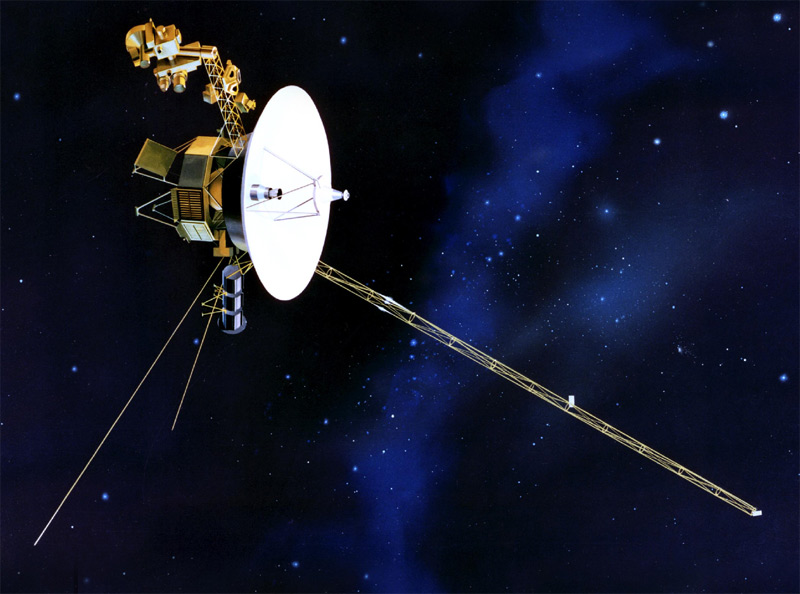We're open daily! View holiday hours
Science News
Voyager’s Great Leap
September 19, 2013
by Elise Ricard

Has Voyager 1 finally left the Solar System?
An answer to this question has been proclaimed so many times in the last few years that it has almost lost its effect. Part of the confusion lies in how we define “solar system.” Is it the edge of planetary orbits or the end of the Sun’s influence…or is there yet another definition?
Launched in 1977, the craft has been hurtling through space at an incredible 38,000 miles per hour, sprinting nearly 1,000,000 miles per day. It passed the orbit of the farthest planet Neptune on August 25, 1989 (at the time, due to its highly elliptical orbit, the then-planet Pluto was closer to the Sun than Neptune). Its twin spacecraft, Voyager 2, actually flew close to the planet itself. In 1990, with their planetary missions accomplished, both Voyager missions were renamed the Voyager Interstellar Mission. This consists of three phases: detection of the termination shock (the edge of the Sun’s magnetic influence, where the solar wind slows); exploration of the heliopause (the interface between the solar wind and the interstellar wind); and exploration of interstellar space (the region where the interstellar wind dominates). In December 2004, Voyager crossed the termination shock. Roughly ten years later, the craft was expected to transverse the heliopause, which many consider the edge of the Solar System.
And on August 25, 2012, 35 years after its launch and 12 billion miles (125.3 AU) from the Sun, Voyager 1 officially crossed into interstellar space.
The determination that the event actually occurred, however, did not come until last week. What took so long?
The Sun ejects plasma material (called the “solar wind”) out into a bubble called the heliosphere. The plasma outside that sphere comes from stellar explosions millions of years ago and has since been dispersed throughout the galaxy. The interaction between the heliosphere and plasma is the boundary between the two.
Voyager was looking to detect that boundary between plasmas; however, it could not do this directly because the plasma detector on Voyager 1 malfunctioned in 1980, just a few years after launch. Instead, scientists measured the magnetic field of the Sun and of the interstellar wind. The change did not manifest as expected, so scientists could not draw a definite conclusion. Another set of instruments on board, two antennae, are able to measure plasma—but only if it is moving in waves. A solar eruption in March 2012 sent a shock wave that took 400 days to reach Voyager, but caused the plasma to react in a way that Voyager could detect. This signal finally enabled the confirmation of the craft’s passage into interstellar space.
Sadly, our connection with Voyager will eventually end as its power runs out (its current power output is about that of a refrigerator lightbulb—try detecting that from 11 billion miles away!) The craft is expected to lose all power and cease its communications with Earth by 2025. With no friction to slow it down, however, Voyager will continue to drift on, indefinitely. It remains well within the sphere of the Sun's gravitational dominion, but will take about 30,000 years to pass through the Oort cloud, the cometary halo extending about a light year or so from the Sun and the farthest-known objects orbiting the Sun. So although the plucky spacecraft has entered interstellar space and left the Sun’s magnetic influence, the Voyager team says it will not yet leave the Solar System until it passes through the Oort Cloud. Beyond that, it will take another 70,000 years to travel the 4.3 light year distance between us and the next closest star, Alpha Centari.
But let’s not underestimate the significance of this event. A man-made object has left the confines of the tiny speck of our galactic home for the very first time and entered the space between stars. We have physically entered a space greater than any explored before and taken the first step in ever visiting other star systems. True, it is a mere 16 light hours, but substantially farther than the 1.3 light seconds to the Moon, which is the farthest that humans have gone.
Voyager leads the way in a whole new frontier of exploration.
Elise Ricard is the Senior Presenter at the Morrison Planetarium and holds a master’s degree in museum education.